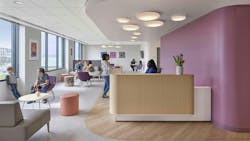The Art and Science of Effective Healthcare Environments
All design affects our wellbeing—but healthcare design especially.
This summer, just as the 2024 IIDA Healthcare Design Awards opened for submissions, we spoke with a trio of former competition jurors about how to craft effective healthcare spaces that promote wellness, provide comfort, and offer peak functionality.
Lilliana Alvarado, founder and design principal at UPHEALING and co-chair of the IIDA New York Healthcare Forum; Aimee Burmaster Hicks, Page principal and interior design director; and Kelley Dorsett, HDR senior interior designer and associate, shared what fuels their creativity, the data and trends transforming healthcare design, and advice for designers aiming to excel. From community integration and cultural sensitivity to innovative technology and sustainability, their insights reveal the thoughtful and empathetic approach needed to create spaces that make us well, and make us feel welcome.
Can you share the key factors that drive your creativity when designing healthcare facilities?
Lilliana Alvarado: I’ve always been interested in the stories of people using the spaces we try to enhance. Particularly in healthcare environments, patients and staff have specific needs and know what works and what doesn’t. Creativity, to me, comes from balancing individual solutions with the larger project goals of our clients.
Aimee Burmaster Hicks: Travel is the number one driver of my creativity. I love getting fresh perspectives and new ideas from other cultures. Aside from the aesthetics—colors, patterns, forms, and light—experiencing the sensitivities of different cultures and seeing what they prioritize and value gets me thinking differently.
Insights from my own experience as a patient, having undergone brain tumor surgery, have underscored the importance of designing spaces that support care staff in multiple ways. These spaces should be inspirational, fostering creativity and interactions, and should include areas that promote innovation and collaboration, as well as spaces that encourage engagement and rest.
Kelley Dorsett:I am inspired by the people I design for. Hearing from caregivers, staff, patients, their families, and the broader community allows everyone to contribute to the creative process. It is important to leave an area better than you found it and promote equity through design. Projects are successful when they provide social value by contributing to economic stability, enhancing access to care, creating secure, inclusive environments that are flexible and adaptable for various populations, and addressing the ever-changing healthcare landscape.
What recent trends in healthcare design do you find the most intriguing? How do you see these trends shaping the future of healthcare environments?
LA: I’m not particularly drawn to trends; instead, I find research compelling. I prefer human-centered and evidence-based design principles because they are supported by solid research. I believe that identifying the right solution for each unique space or client is the best approach to creating functional, customized, and distinctive environments.
ABH: It couldn’t be a more exciting time in healthcare design to actively engage in future-thinking—this effort involves collaboration with innovators outside the traditional multi-discipline team structure, like immersive experience designers and AI technology experts. Key areas include community integration, which goes beyond the “wellness hub” idea of integrating nutrition and fitness classes into a facility to emphasize inclusivity and accessibility.
How easy is it to travel to the facility on public transportation? Are the programs appropriate for the community’s diverse population, such as the elderly, people with sensory processing differences, or physical disabilities? Creating spaces that respect and accommodate diverse cultural needs, languages, abilities, and practices is crucial. Additionally, it’s important to think flexibly and normalize virtual consultations and remote patient monitoring to create ambient, seamless patient experiences that are controllable and personal, thereby increasing patient engagement and participation in their own health journey.
Finally, safety is paramount in healthcare design, ensuring patients, families, and staff feel secure both physically and emotionally. With healthcare workers increasingly on the front lines of violence, it’s crucial to thoughtfully design and locate both visible and invisible security barriers. Beyond establishing physical security, designers must create spaces that are welcoming, inclusive, and accommodating, fostering a sense of belonging and security for everyone.
KD: Healthcare design trends are currently focused on integrated technology, human-centered design, and sustainability. Data-driven design allows for quick adaptation planning, increases operational efficiency, and improves patient satisfaction. Advanced technology solutions, such as user-friendly apps and telemedicine, enhance inclusivity, reduce stress, and increase access, offering more convenient care for less complex health issues. Sustainability efforts aim to lessen environmental impact through enhanced energy efficiency, water conservation, waste reduction, and improved indoor air quality, and regenerative healing environments promote wellbeing and future resilience.
You were recently a juror for IIDA’s Healthcare Design Awards. What sort of design approaches caught your eye? Any advice for healthcare designers looking to wow clients (and maybe even win competitions)?
LA: I always feel honored to be a juror for these amazing design awards. When judging submissions, I am initially drawn to beautiful photography that showcases innovative solutions and attention to detail. Good design doesn’t need to be expensive; two award-winning projects stood out for their thoughtful execution, even with budget constraints. These projects had a compelling story and a strong “why” behind the design. My advice to designers is to be thoughtful and use empathy, especially in healthcare settings.
ABH: Interestingly, several of the winning teams had little to no healthcare experience, suggesting that a fresh perspective can be highly valuable. This doesn’t undermine the importance of expertise but highlights the need for designers to continually challenge themselves and their clients. My advice to designers:
- Think beyond the familiar. Continuously seek out new ideas and approaches that push the boundaries of conventional healthcare design.
- Challenge yourself and your clients. Encourage innovation and creativity by questioning traditional methods and exploring new possibilities.
- Prioritize emotional and cultural sensitivity. Create spaces that feel safe and welcoming for all users.
- Do not downplay the importance of beauty. Strive for designs that are not only functional but also beautiful, enhancing the overall experience for patients, staff, and visitors.
KD: The approaches that resonated with me were the projects that honored the community they served. I saw the application of familiar forms, the distinctive use of color, and culturally responsive design. As for advice: Go beyond the functional program requirements to do what’s best for the community you are designing for; involve them in the process. Bring empathy, wellness, efficiency, and creativity into all spaces.
Submissions are open for the 2024 IIDA Healthcare Design Awards through September 9.
*Responses have been lightly edited for length and clarity.



